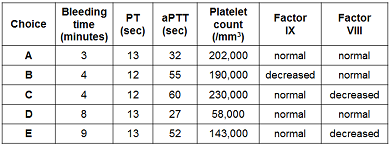Check out today’s Step 2 CK Qmax Question Challenge.
Know the answer? Post it in the comments below! Don’t forget to check back for an update with the correct answer and explanation (we’ll post it in the comments section below).
 A 10-month-old baby boy who is bleeding profusely from the mouth is brought to the emergency department. The mother states that the baby cut himself with his newly erupted teeth after chewing on a teether ring. She also states that he has been bruising easily as well, but thought nothing of it. Upon further questioning, a family history of “bleeding” is present in the maternal grandfather. On examination, there is active bleeding in the oral cavity. Vital signs are stable, the baby is active but distressed.
A 10-month-old baby boy who is bleeding profusely from the mouth is brought to the emergency department. The mother states that the baby cut himself with his newly erupted teeth after chewing on a teether ring. She also states that he has been bruising easily as well, but thought nothing of it. Upon further questioning, a family history of “bleeding” is present in the maternal grandfather. On examination, there is active bleeding in the oral cavity. Vital signs are stable, the baby is active but distressed.
Which of the above laboratory findings are characteristic of hemophilia B? PT refers to prothrombin time, and aPTT refers to activated partial thromboplastin time.
A
B
C
D
E
______________________
Want to know the ‘bottom line?’ Purchase a USMLE-Rx Subscription and get many more features, more questions, and passages from First Aid, including images, references, and other facts relevant to this question.
This practice question is an actual question from the USMLE-Rx Step 2 CK test bank. Get more Step 2 CK study help at USMLE-Rx.com.




B
B
B.
B
B
B
B. Hemophilia B is an X-linked recessive coagulation disorder due to factor IX deficiency. Bleeding time is a job of primary hemostasis, thus it only serves to look after quantitative or qualitative disorders of platelets, not coagulation factors. Also PT -> Extrinsic Pathway, and PTT -> Intrinsic Pathway (factors VIII and IX included). Normal Bleeding Time: 2-7min. Normal Platelets: 150k-450k/uL. Normal PT: 11-15s. Normal aPTT 20-35s.
Thank you for the explanation. This is always very helpful for review.